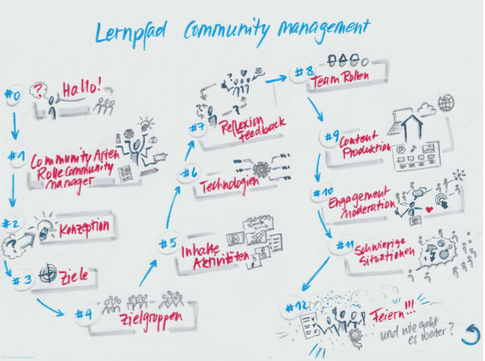In today’s interconnected world, building communities has become a crucial aspect of many organizations‘ strategies. Communities offer a unique platform for fostering connections, sharing knowledge, and driving innovation.
However, the complexities of community development, with numerous factors at play, can be overwhelming. From identifying target audiences to activating user engagement, establishing roles and responsibilities, selecting the right technical platform, and defining rules and guidelines, there is much to consider.
To navigate through these complexities and showcase the interconnectedness of these diverse elements, I have developed the Community Circle Model. Drawing upon my 16 years of professional experience in community building, I have extensively tested and refined this model in numerous workshops and training sessions over the past four years, witnessing its effectiveness across various contexts.
The Community Circle model provides a versatile framework for success in community building, offering valuable insights that can be applied to a wide range of community initiatives. Whether you are at the early stages of conceptualizing a community, actively developing one, or seeking to improve an existing community, this model is designed to guide your efforts. It is applicable to communities focused on internal or external target groups, operating in social networks or on owned platforms, and whether they primarily exist online or offline. By leveraging the Community Circle framework, you can ensure a holistic approach to community building, fostering engagement, and achieving long-term sustainability.
With the Community Circle model, you will gain a deeper understanding of the key elements necessary for building and maintaining a thriving community. By exploring the four main sections of the framework—Strategy, Culture, Platform, and Community Manager—you will discover how each element contributes to the overall success of your community. Furthermore, you will recognize the interwoven nature of these elements and how they rely on one another for optimal community engagement.
Strategy: Setting the Foundation
A solid strategy is the backbone of any successful community. It sets the direction and purpose of the community, guiding its growth and ensuring alignment with organizational goals.
Culture: Creating a Sense of Belonging
A strong community culture fosters a sense of belonging and creates an environment where members feel comfortable engaging and sharing.
Platform: Providing the Right Environment
The platform serves as the virtual or physical space where community members gather, connect, and share.
Community Manager: Guiding and Nurturing the Community
Community managers play a crucial role in guiding and nurturing the community, supporting member interactions, and fostering a positive community environment.
The graphic representation below illustrates the interrelation and equal importance of each element: Strategy, Culture, Platform, and Community Manager.
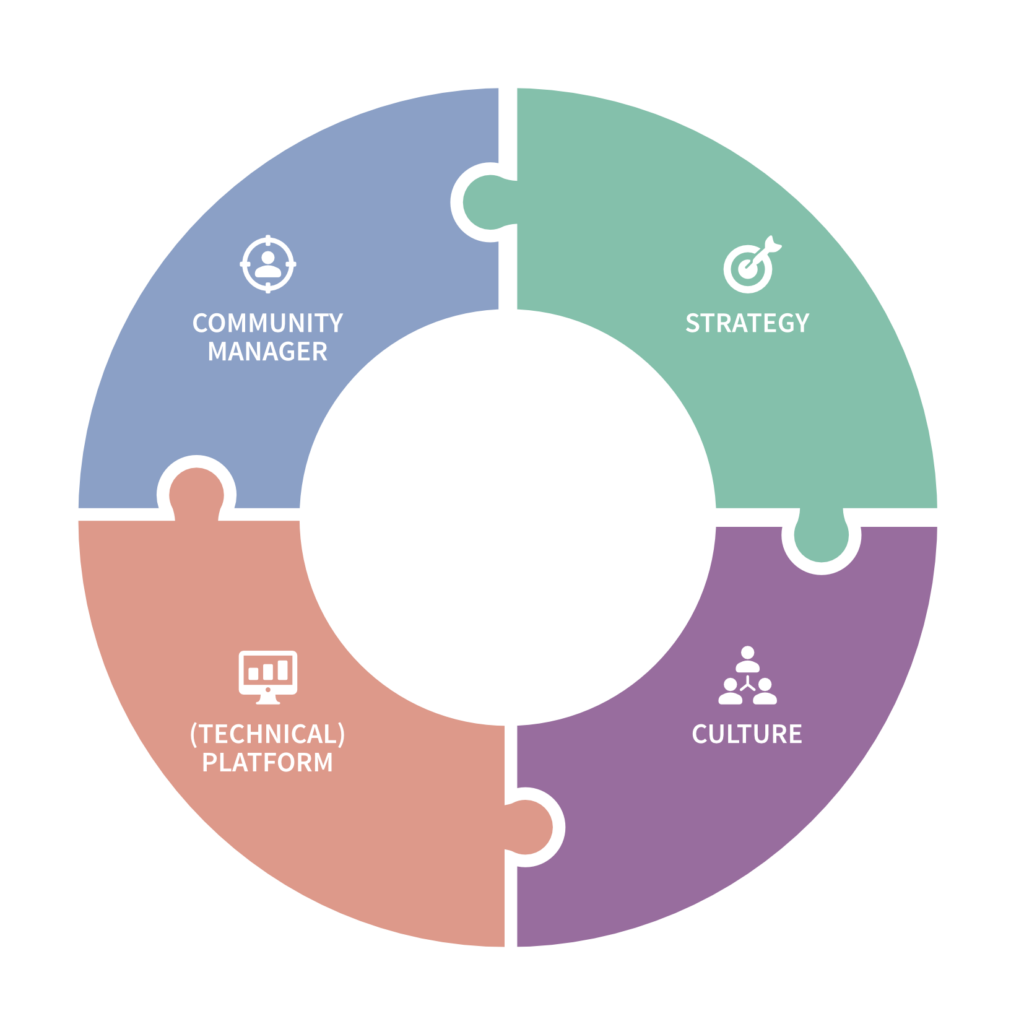
By combining and effectively developing these elements, you can nurture a strong sense of belonging and engagement among members. When all four elements are in place and working harmoniously, your community will thrive, fostering meaningful connections, driving knowledge sharing, and achieving long-term sustainability. The Community Circle model empowers you to build and nurture an active, resilient, and successful community. Let’s have a closer look at the four core elements and the engagement methods.
Community Strategy: Mapping the Path to an Engaged Community
The Community Strategy section is an essential component within the Community Circle model, providing the necessary foundation for building and maintaining a thriving community.
By developing a comprehensive strategy, you establish a clear direction and purpose, guiding your community’s growth and ensuring alignment with its overarching goals. Without a well-defined strategy, your community may lack a common vision that inspires and engages its members. Furthermore, securing resources and support from your organization to build and sustain the community becomes challenging. A strong strategy is the key to fostering member engagement and obtaining the necessary resources for community success.
Without a clear strategy, you have a gathering without a clear direction and not a community.
A compelling and shared vision drives member engagement, fosters their intrinsic motivation, and secures the necessary resources for community success
Within the Community Strategy section, several key subsections play crucial roles in shaping your community’s growth and development:
Purpose & Goal: Defining the core purpose and goals of your community establishes a solid foundation aligned with your organization’s values and aspirations. By clarifying your community’s mission, vision, and objectives, you provide a clear focus for community members, guiding their engagement and fostering a shared sense of purpose.
Target Audience: Understanding your target audience is essential for tailoring your community’s offerings to their unique characteristics, needs, motivations, values, and interests. By gaining deep insights into your audience, you can create a compelling experience that resonates with their expectations.
Resources: Allocating the necessary resources, including budget, time, and expertise, is vital to support the successful operation, engagement, and outcomes of your community. Adequate resource allocation ensures that you have the means to sustain and nurture your community effectively, driving active participation and achieving desired results.
Roadmap: Creating a comprehensive roadmap provides a well-structured and organized approach to community development. By outlining key milestones, activities, and deliverables, you can track progress and ensure that your community evolves in a purposeful and strategic manner.
Data Analytics: Measuring the success and impact of your community is essential for gathering valuable insights. Data-driven analysis empowers you to make informed decisions, identify areas for improvement, and continuously enhance the community experience.
Marketing: Effective marketing strategies are essential for promoting your community, attracting new members, and increasing engagement. By leveraging various channels and techniques, you can effectively communicate the value and benefits of your community to your target audience.
Development: Communities are dynamic entities that require continuous improvement and adaptation. By establishing feedback loops, gathering member insights, and staying attuned to changing needs and trends, you can ensure that your community remains relevant, engaging, and aligned with the evolving expectations of its members.
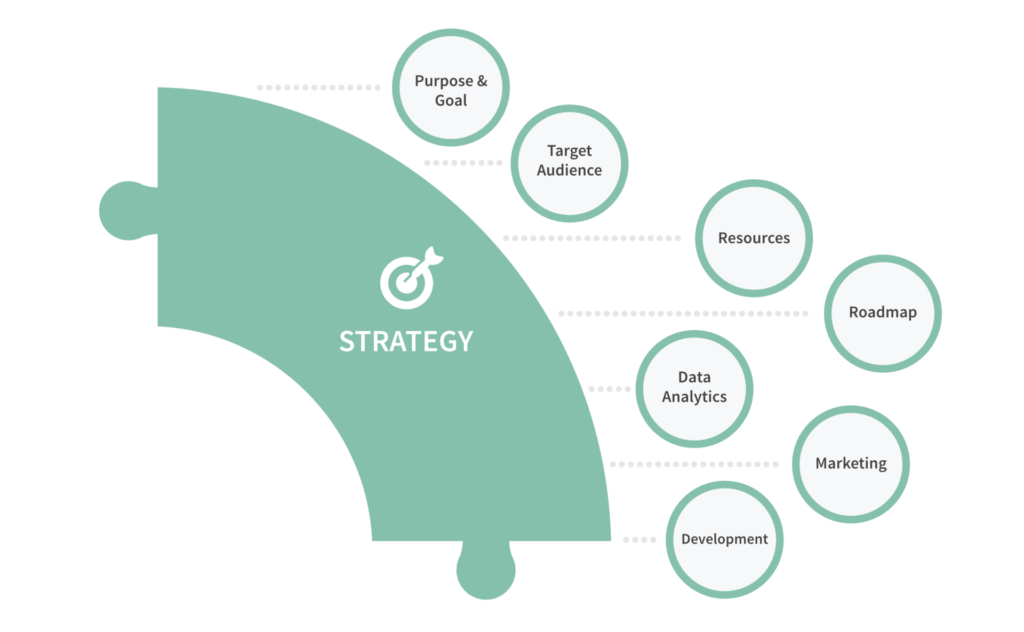
The Community Strategy section of the Community Circle framework serves as the foundation for building and maintaining a thriving community. By establishing clear goals and direction, understanding your target audience, allocating necessary resources, creating a roadmap, utilizing data analytics, implementing effective marketing strategies, and focusing on continuous development, you can cultivate a community that inspires and engages its members. A strong strategy not only drives member engagement and fosters a shared sense of purpose but also ensures the availability of necessary resources for community success and continuously evolves to meet the needs of its members.
Culture: Fostering Belonging and Connection
Culture is a fundamental element in building a thriving and engaged community. It encompasses the values, beliefs, experiences, language, symbols, and rituals, and the rich tapestry of emotions that shape the community’s identity and create a sense of belonging among its members. Through fostering a strong community culture, you establish an environment that encourages active engagement, collaboration, and meaningful interactions
Without a vibrant culture, you have an audience, not a community.
What is lost are meaningful engagement, shared experiences, and authentic connections that define a strong community.
Let’s explore the key elements within the Culture section that contribute to the formation of a vibrant and connected community.
Sense of Community: At the core of a vibrant community lies a shared sense of community. Here, we focus on cultivating shared beliefs, values, and experiences that unite members. By creating commonalities, symbols, rituals, and a shared language, you foster a strong sense of identity and belonging, enabling members to connect on a deeper level and establish meaningful relationships.
Environment: Creating a welcoming and inclusive environment is crucial for community engagement. We aim to create an inclusive and welcoming environment with low barriers to participation. By setting a positive and respectful tone, moderating discussions effectively, and showing appreciation for member contributions, we cultivate a safe and supportive space where individuals feel comfortable engaging, sharing ideas and knowledge and collaborating with each other.
Core Group: Within the community, a core group of dedicated members plays a pivotal role in driving engagement and fostering community spirit. It is essential to identify and nurture the members of the core group. This group consists of passionate individuals who are deeply committed to the community’s mission and actively contribute to its growth and development. By empowering and involving the core group, you inspire other members to actively participate, share their insights, and contribute to the community’s success. The core group is therefore creating a ripple effect of involvement.
Onboarding: The onboarding process sets the stage for new members to integrate into the community. Through an effective on-boarding process, we guide new members, familiarize them with community values and norms, and provide resources and support to facilitate their active participation. By providing a seamless and engaging onboarding process, you facilitate a smooth transition, enhance members‘ initial experience, help newcomers to feel valued, and increase their likelihood of becoming active and engaged community participants.
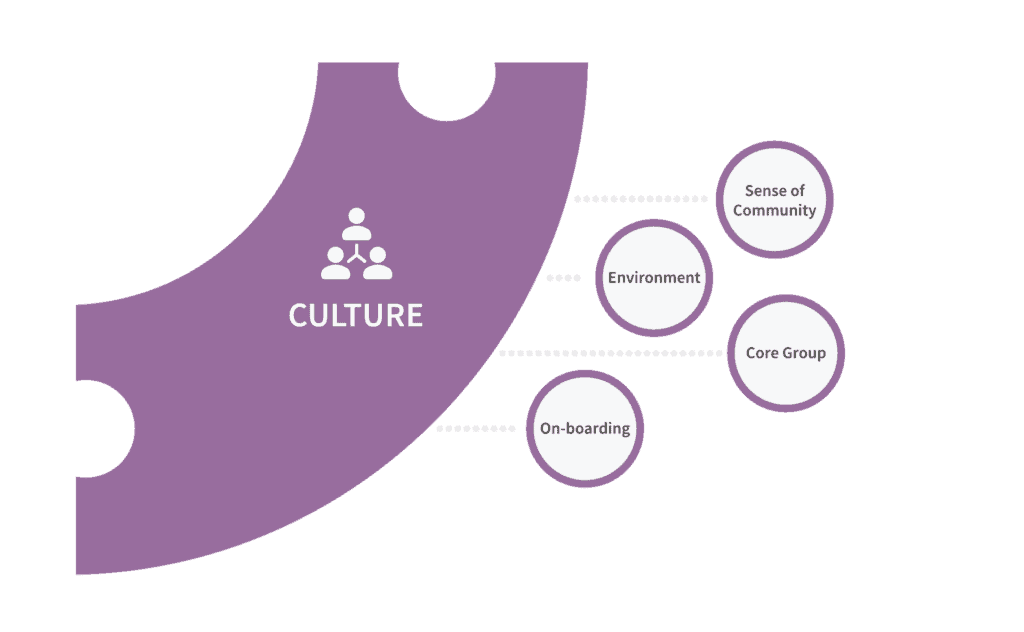
Through emphasizing these culture-building elements, you create an environment where members feel a strong sense of community, fostering engagement, collaboration, and a shared commitment to the community’s purpose and goals. The culture of your community serves as a catalyst for active participation, meaningful connections, and sustained engagement.By nurturing a positive and inclusive community culture, you encourage active participation, build trust among members, and create a strong foundation for collaboration and growth.
Platform: Providing the Space for Connection
The platform serves as the space where community members come together to exchange ideas and experiences. It can be a physical location or a digital platform. Whether you choose in-person meetings, social networks, or your own owned platform, each option has its unique considerations and implications. In the component of the (technical) platform, I introduce the key components that shape the meeting space of your community, including digital tools.
Without a dedicated platform for exchange, you have a loose network rather than a cohesive community.
The right (technical) platform provides a permanent space for community members to connect, collaborate, and build meaningful relationships.
Let’s explore these elements and uncover how they contribute to creating a thriving and connected community.
In-person Meetings: When selecting in-person meetings as the primary mode of connection for your community, you need to carefully consider factors such as location selection, space design, logistics, and organization. These factors are essential in creating a conducive environment where community members can come together, connect, and collaborate effectively, fostering meaningful face-to-face interactions.
Social Networks: Choosing groups in social networks as the main platform for your community presents unique opportunities and challenges. Evaluating the pros and cons, including audience reach, engagement features, privacy settings, and limitations within the social network, is important.
Owned Platform: Deciding to build and maintain your own platform provides you with greater control and flexibility over your community’s digital space. As you consider this option, you will need to assess platform criteria, select a suitable provider, evaluate functionality and features, and prioritize usability and user experience.
Digital Tools: In addition to your chosen platform, various digital tools can enhance community interactions, facilitate communication, and provide valuable insights through analytics. Depending on your specific needs and goals, exploring tools such as communication channels, moderation tools, and analytics tools can optimize the community experience.
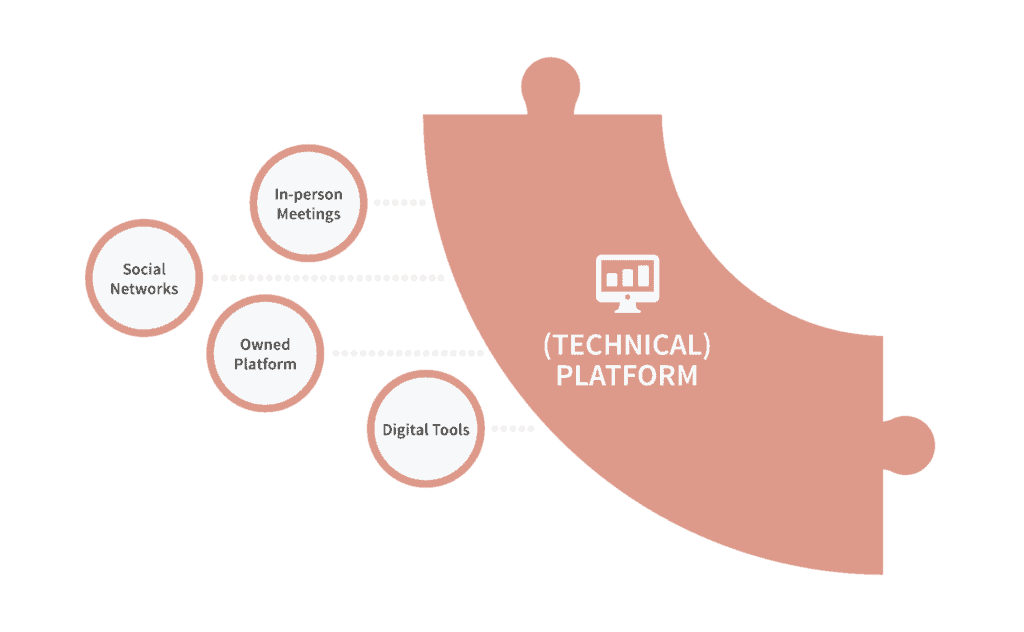
By carefully selecting and utilizing the appropriate (technical) platform, you create an environment that encourages community members to connect, share, and collaborate.
Community Manager: Guiding and Supporting the Community
As the primary facilitator and advocate of the community, the Community Manager plays a crucial role in nurturing engagement and driving the growth of the community. With a diverse skill set and a deep understanding of community dynamics, they create a vibrant and inclusive environment where members can connect, collaborate, and thrive. By utilizing effective tools, implementing streamlined systems, and leveraging their expertise, Community Managers empower the community to flourish and achieve its goals.
Without a dedicated community manager, the community lacks direction, coordination, and support, leaving it adrift and disconnected.
The community manager’s expertise and guidance are essential for fostering engagement, building relationships, and harnessing the full potential of your community.
Let’s delve into the distinct dimensions of the Community Manager’s role, encompassing the diverse variations they encounter while engaging with different target groups and navigating various platforms.
Variations: Community Managers fulfill diverse roles depending on the specific nature and context of the community they serve. They interact with diverse target groups, external or internal and have different main platforms like in-person meetings, social networks or owned platforms. These unique variations require Community Managers to adapt their strategies and approaches to meet the specific needs and challenges of each context.
Capabilities: Successful Community Managers possess a unique skill set and a combination of attributes that enable them to effectively carry out their tasks and roles. These may include content development, moderation, event organization, community advocacy, and relationship-building. Community Managers should have excellent communication and interpersonal skills, a deep understanding of community dynamics, and the ability to facilitate meaningful interactions and discussions among members.
Tools: Community Managers utilize a range of resources to optimize their work and enhance community management. These resources include implementing netiquette guidelines, developing a comprehensive plan for topics and activities, a handbook and a crisis communication plan. The tools utilized can vary based on the nature and platform of the community. They enable Community Managers to navigate the complexities of community management and foster a thriving and harmonious community environment.
Systems & Workflows: Community Managers serve as a vital interface between the community and different departments within the organization. They collaborate with cross-functional teams to align community goals with organizational objectives and ensure that valuable community knowledge is shared and utilized effectively. Well-defined structures and processes enable Community Managers to capture, organize, and leverage community-generated knowledge, fostering informed decision-making and driving innovation throughout the organization.
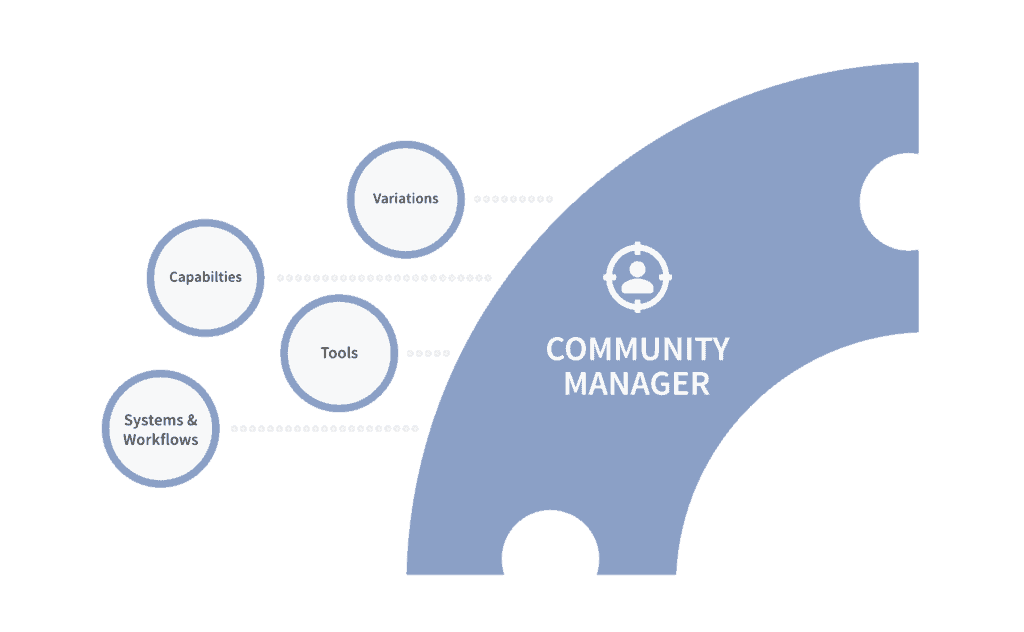
A skilled and dedicated Community Manager plays a pivotal role in building and nurturing an engaged community. They serve as the catalyst for engagement, facilitate meaningful interactions, and create an inclusive and supportive environment where members can thrive. By understanding the variations in their role, honing their capabilities, utilizing appropriate tools, and implementing effective systems and workflows, Community Managers can drive the growth and success of the community they serve.
Building Engaged Communities: The Synergy of Strategy, Culture, Platform, and Community Manager
Building a successful and engaged community requires the integration and synergy of all four key elements of the Community Circle framework. Each element plays a crucial role in shaping the community’s foundation, growth, and sustainability. Without any one of these elements, the community-building process is incomplete, and the desired outcomes may not be achieved.
The Strategy component sets the direction, goals, and purpose of the community, providing a compelling and shared vision that drives member engagement, intrinsic motivation, and secures the necessary resources for community success. It establishes a clear roadmap and ensures that the community stays aligned with its overarching goals.
The Culture element fosters a sense of community, shared beliefs, values, and experiences that create a vibrant and connected environment. It enables meaningful engagement, authentic connections, and shared experiences that define a strong and cohesive community. Without a vibrant culture, the community risks becoming an audience, lacking the essential elements that define a thriving community.
The (Technical) Platform element provides a dedicated space for community members to connect, collaborate, and build meaningful relationships. Whether it’s in-person meetings, social networks, or owned platforms, the right platform choice ensures seamless interactions, permanent connections, and a sense of belonging within the community. Without a dedicated platform, the community remains fragmented, lacking a cohesive space for members to come together.
The Community Manager serves as the primary facilitator and advocate of the community. Community Managers fulfill diverse roles depending on the nature and context of the community. They engage with internal and external target groups, navigate different platforms, and adapt their strategies to meet specific needs and challenges. Community Managers possess a diverse skill set and knowledge of community dynamics that are crucial in nurturing the growth and engagement of the community. Without a dedicated Community Manager, the community lacks guidance, support, and the crucial interface with various departments within the organization.
These four elements of the Community Circle framework are interconnected and woven together, creating a holistic approach to building and sustaining a thriving community. Each element relies on and complements the others, forming a strong and cohesive ecosystem. Strategy sets the direction, Culture fosters the sense of community, the (Technical) Platform provides the space for connection, and the Community Manager drives engagement and collaboration.
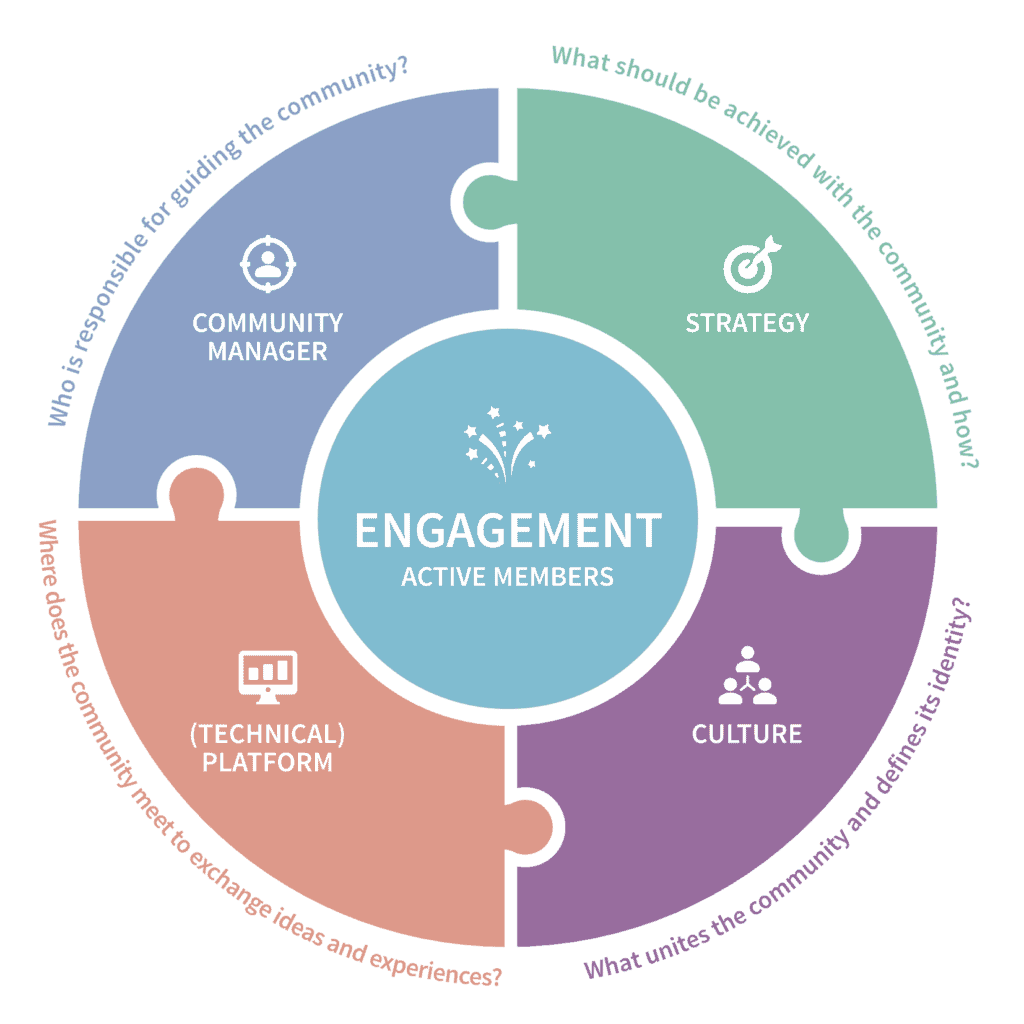
By understanding and integrating these interconnected elements, community builders can create an environment where members feel inspired, engaged, and connected. It is the harmonious interplay and balance of strategy, culture, platform, and community manager that lays the foundation for a successful and vibrant community.
Engagement: Driving Active Participation and Meaningful Interactions
A strong and engaged community is built upon a solid foundation of the four key elements. Without these foundational elements in place, no matter what engagement strategies you employ and no matter the quantity of tactics you try you won’t be able to fully unlock the true potential of your community.
When all four elements are in place, you can explore various engagement tactics and methods, including:
Communication & Collaboration: Effective communication and collaboration are vital for community engagement. By establishing clear channels of communication, encouraging open dialogue, and facilitating collaboration among members, you create an environment that fosters active participation and collaboration.
Content Strategy & Planning: A well-defined content strategy ensures that you deliver valuable and relevant content to your community. Through thoughtful planning, you can create engaging content that resonates with the community’s interests and goals, keeping members informed, inspired, and connected.
Events & Activities: Organizing events and activities provides opportunities for community members to connect, learn, and engage in interactions. Whether it’s hosting webinars, workshops, virtual meet-ups or face-to-face-gatherings, events bring members together and facilitate meaningful connections.
Gamification & Reward Systems: Gamification techniques can enhance engagement by adding an element of fun and additional motivation. By implementing gamification elements such as points, badges, leaderboards, and challenges, you can encourage members to actively participate, contribute, and achieve certain milestones. Reward systems can further incentivize engagement and recognize the contributions of community members, fostering a sense of accomplishment and loyalty.
Empowerment: Empowering community members to take ownership and contribute to the community’s growth is key to sustained engagement. This involves providing opportunities for members to share their expertise, lead initiatives, and contribute to decision-making processes. By giving members a sense of ownership and responsibility, you create an environment where they feel valued, empowered, and motivated to actively participate and contribute.
Super-User Program: Recognizing and empowering highly engaged and influential members through a super-user program can have a significant impact on community engagement. Super-users serve as advocates, mentors, and role models, inspiring and influencing others to actively participate, contribute, and engage within the community.
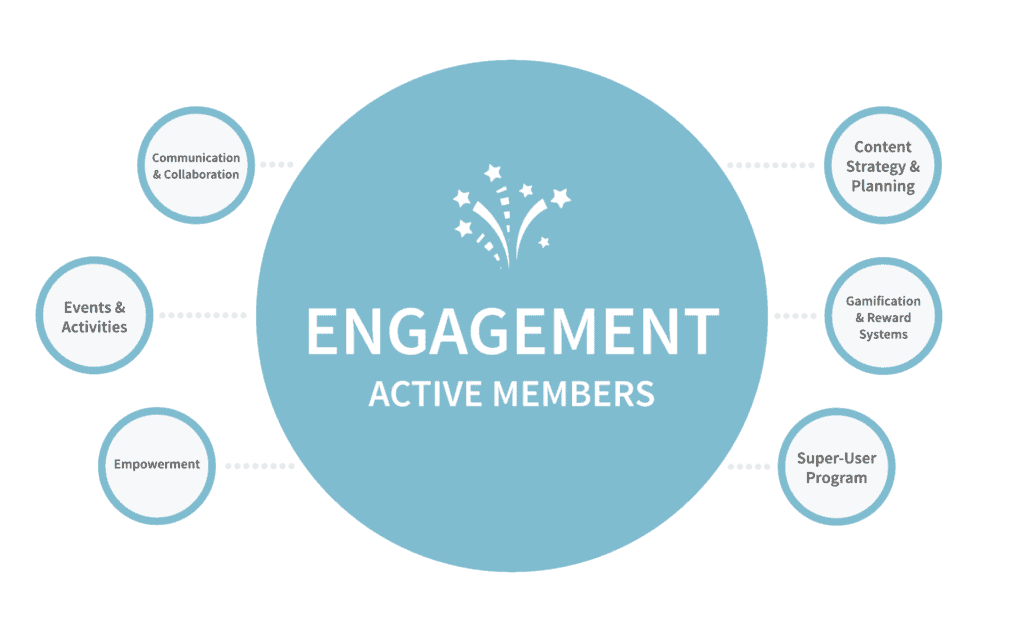
The implementation of these engagement tactics and methods not only allows you to create an active and engaged community environment, but also to support the continuous evolution of your community and achieve its goals. In doing so, you create an environment where community members feel connected, motivated, and excited, and are happy to contribute to the growth and success of the community.
Guiding Your Journey: The Community Circle Framework for Building Dynamic and Engaged Communities
In the ever-evolving landscape of community building, the Community Circle framework serves as a guiding compass for creating thriving and engaged communities. Strategy, culture, platform, and the community manager are intertwined, mutually supportive, and thus form the backbone of any successful community. They provide the necessary framework for active participation, collaboration, and a sense of belonging. By purposefully integrating these essential elements, community builders establish an ecosystem where meaningful connections flourish, collaborative efforts thrive, and collective goals are accomplished.
A clear and compelling strategy sets the direction and purpose of the community, driving member engagement and securing the necessary resources for success.
Cultivating a vibrant culture fosters a sense of belonging, shared experiences, and authentic connections, transforming a mere audience into a cohesive community.
Choosing the appropriate platform, whether it’s in-person meetings, social networks, or an owned platform, provides a consistent space for community members to connect, collaborate, and cultivate meaningful relationships.
The role of a Community Manager is vital in facilitating interactions with diverse target groups, ensuring smooth operations and adapting strategies to meet the unique variations of each community context.
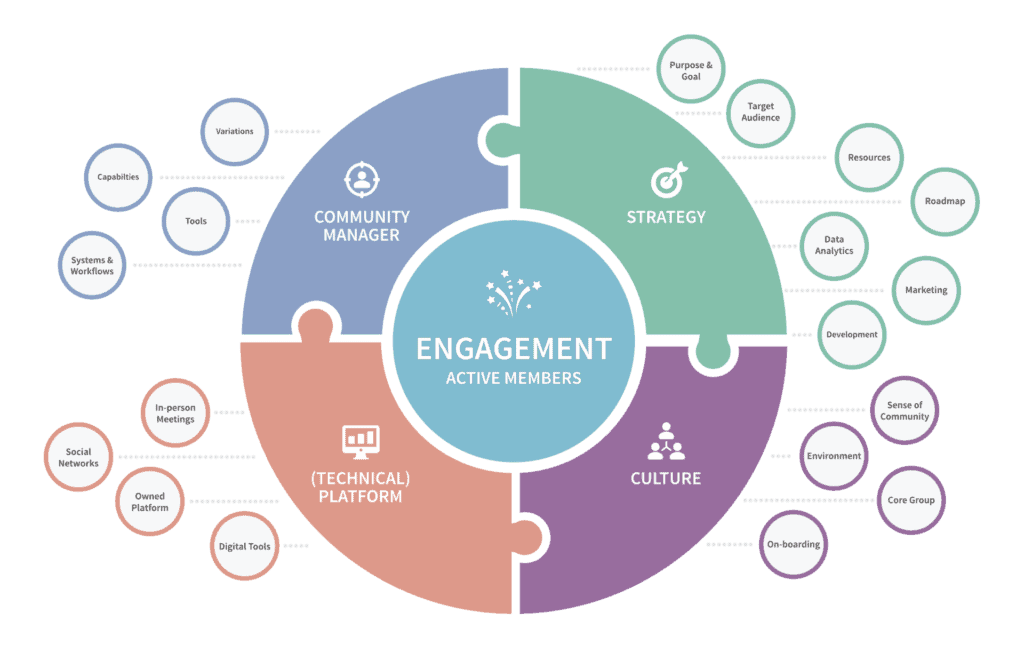
By integrating these four elements, community builders unlock the true potential of their communities. Engagement tactics and methods, such as effective communication, strategic content planning, engaging events and activities, gamification, reward systems, and the empowerment of community members, become powerful tools for driving active participation and collaboration.
In the pursuit of community building, it’s essential to remember that engagement is not just about generating activity for the sake of activity. Rather, it is the meaningful connection and interaction that lead to tangible outcomes. As community builders, our efforts should be geared towards fostering interactions that drive real impact and create value for both community members and the organization. By aligning engagement activities with specific goals and outcomes, we can measure the success of our community-building initiatives and ensure that they make a meaningful difference in the lives of the members and the community as a whole.
As you embark on your community-building journey, remember that the Community Circle framework is more than just a compass – it’s a roadmap that guides your path. The road to building a successful and engaged community may have its challenges, but with the Community Circle as your guide, you possess the tools and strategies to create a community that inspires, empowers, and makes a lasting impact.

